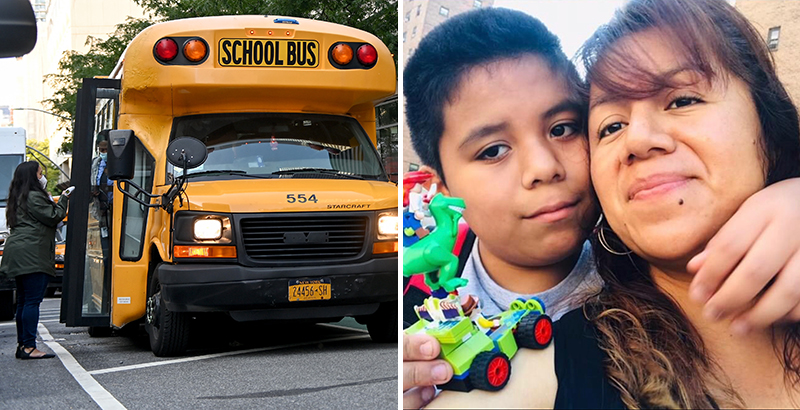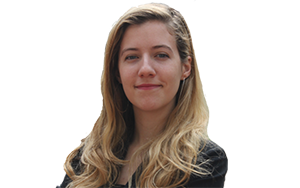The First Day of School Came and Went for NYC Special Needs Students Stranded Without a Nurse or Other Adult Required to Ride the Bus With Them

Eleven-year-old Benjamín Miranda should have been among the first New York City public school students to return to in-person learning on Monday, but he couldn’t board the bus to get there.
Benjamín is among the roughly 25,000 students with significant disabilities whose specialized schools were given priority to reopen by Mayor Bill de Blasio last week, despite the start of nearly all other city schools being delayed a second time during the pandemic. Because Benjamín has special needs, a paraprofessional is required to ride the bus with him to his Brooklyn school. Come Monday, there wasn’t one.
That last-minute news set his mother, Adriana Maya, on a familiar quest to scale the obstacles standing between her son and his education.
“Every single year, I have to fight for my son,” says Maya, a single mother from Mexico who holds down two jobs, working as a crossing guard and cleaning apartments. “I’m his voice, so I need to do it.”
While advocates offering legal aid to underserved communities were unable to quantify the number of students affected, they say that Benjamín isn’t alone. Other students attending District 75 schools scheduled to return to in-person classes this week for the first time since the March shutdown were unable to do so, they report, due to a lack of “bus paras” and “bus nurses” needed to get them there.
“Everyone’s talking about the shortage of teachers, but no one’s talking about the extra [staff] needed for special needs students,” says Paola Jordan, who has helped Maya advocate for her son over the years. Jordan co-directs Sinergia, an organization offering free support groups and workshops to the families of school-age children with disabilities.
“When you need an extra person on the bus, that’s a challenge,” she adds. “It’s important to identify that that responsibility is on the school, not the parent.”
An hour after receiving a check-in call from Benjamín’s bus driver last Thursday morning, Maya called P.S. 231 in Brooklyn, where her son was supposed to start sixth grade. She says a woman called Daisy, who wouldn’t provide her last name or title, answered the phone. Daisy gave three reasons Benjamín couldn’t come to school on Monday, Maya says: He lives in a different borough (Manhattan) than where the school is located; there wasn’t a paraprofessional available to ride the bus with him; and finally, the staffer said that Benjamín’s mother had been late to retrieve her son from school last year, an allegation that Maya said is untrue.
Bus drivers are generally notified in advance about the needs of the children riding in their vehicles, explains Maggie Moroff, special education policy director at Advocates for Children of New York. If a bus driver finds a student alone at the curb, without the paraprofessional or nurse required by their Individualized Education Program (IEP), the driver can’t let that child on board.
“If a student needs support on the bus, it is critical that the student have support on the bus,” Moroff says. “The paras and nurses are for the safety of the student and, in some cases, for those around them.”
City Councilman Mark Treyger, who chairs the Education Committee and has been a regular critic of the mayor’s troubled reopening plan, said last week that he’s been pushing City Hall for answers on the issue. “I haven’t gotten a commitment that every kid that needs it will have a nurse on the bus,” he told The 74.
For months, Mayor de Blasio has stressed the importance of a return to in-person schooling, citing New York’s low 1.1 percent virus positivity rate and the disproportionate harm remote learning has had on low-income students of color, who make up the majority of the city’s 1.1. million students. Special education students have particularly struggled with online instruction, and while advocates say that many of their caretakers are distressed about the regression they’re seeing in their kids, they’re also worried about the viability of a safe reopening.
“The idea of social distancing from a student with level 2 or 3 autism, meaning they have moderate to severe impairments, is incomprehensible,” one longtime observer of District 75 schools wrote in an op-ed for Chalkbeat this week. “Students with autism and others with highly specialized requirements need in-person school more than other student populations, but the actual work puts both teachers and the students at risk for transmitting COVID-19.”
Meanwhile, City Hall is facing a $9 billion shortfall, affecting everything from teacher staffing to the students still lacking devices. Under the mayor’s latest plan, schools are scheduled to reopen to elementary school students Sept. 29 and to middle and high schoolers Oct. 1. Pre-K students returned to their schools on Monday with the District 75 students.
Moroff says the lack of appropriate staffing on buses can be attributed to city leadership’s delayed timeline in approaching the problem of back-to-school transportation amid a pandemic.
“The DOE was still reaching out to kids last week to tell them about routes,” she says. “A lot of families are concerned about whether students that have IEPs requiring a para or nurse will have that in place, even with the late start. Without it, that bus ride is pretty untenable.”
Officials from the Department of Education declined to comment on the details of Maya’s case by deadline. They also would not say how many paraprofessionals and nurses the DOE is lacking for District 75 students needing them in order to ride the bus. Citing DOE figures, Gothamist reported this week that 14,000 District 75 students had opted for in-person learning, while 11,000 chose to continue with remote instruction.
Advocates say the DOE has long had issues delivering students with disabilities the transportation staff they need — particularly nurses. They say the problem stems from an arduous application process and miscommunication between the various groups involved: Every year, each family has to submit a new medical authorization form bearing a doctor’s signature to the Office of School Health, which approves one-to-one nurse assignments. There are a number of steps between that decision and the nurse actually arriving at the student’s doorstep, each riddled with potential roadblocks.
In 2017, Advocates for Children filed a lawsuit on behalf of the parents of three students for whom the delays meant not attending school at all — in two cases, for over two years.
“We’ve been seeing families denied nurses since 2015,” says attorney Rebecca Shore, who spearheaded the suit. “I was hoping that practices and systems could have changed. But the problems inherent in the system are still there.”
That was all before the pandemic. Shore suspects that due to COVID, many caretakers weren’t able to submit the medical authorization forms required to secure one-to-one nurses for their children this year. Typically, that happens in spring or summer for the following fall.
Families also didn’t receive the usual mailed, end-of-summer notices about transportation plans, making matters even messier, says Amy Ming Tsai, a parent on the busing committee for District 75.
Bewildered by that change, some parents tried calling and emailing the Office of Pupil Transportation to no avail, according to Tsai. She says that, as a result, some of the families decided not to send their students into school buildings this week.
For many special needs students, access to buses is paramount, Tsai explains.
“Buses are a priority for District 75, even over related services,” she says. “For most families — families in poor neighborhoods, parents working three jobs — busing is access. For a lot of parents, if the para or nurse doesn’t show up, the child will be stuck at home.”

Instead of starting middle school on Monday, Benjamín spent the afternoon in Hamilton Fish Park writing, reading and painting under the watchful eye of his two siblings, 16-year-old Diana and 22-year-old Víctor, a Marine veteran. He didn’t know that it was supposed to be his first day of school, his mother says.
“He’s not able to understand the pandemic and its long-term implications,” she explains. Until Maya knows for certain what learning this fall will look like for her son, she can’t tell him — a last-minute change could throw him into a deep anxiety. “I can’t tell him that something’s going to happen, unless it’s going to happen,” she says.
Before the pandemic, the 11-year-old received an array of services related to his autism, ADHD, speech disorder and echolalia: just over 10 hours a week of applied behavior analysis (which breaks down everyday tasks), occupational therapy (which develops attention span and motor function), speech therapy, physical therapy and counseling. Maya says that two years ago, she had to hire a lawyer before the Department of Education agreed to cover Benjamín’s ABA therapy.
Those lessons went remote after school buildings were shuttered but remained the same length overall, with the exception of the ABA therapy, which, with its two-hour running time, had started agitating Benjamín.
Even though her son isn’t currently receiving the rest of his services, Maya’s still holding out hope for him this school year — “that he’ll be able to do his school courses again, that he’ll learn how to read more, be more social, do things more spontaneously,” she says.
On Tuesday morning, a few days after soliciting Paola Jordan’s help, Maya got a call from an official at District 75’s placement office. He said that the busing issue had arisen because no paraprofessional at P.S. 231 would agree to ride between boroughs, given the pandemic, according to Maya. And he offered Benjamín a spot at one of two Manhattan schools. As of Tuesday, she hadn’t been given specific names.
There are 57 District 75 schools. Tsai worries about the fate of the special needs students attending them, who don’t have a parent advocate like Maya.
“She was lucky,” Tsai says. “But for the most challenged families, they don’t know what their rights are or who to go to. They don’t have these resources. They don’t know what to do.”
Get stories like these delivered straight to your inbox. Sign up for The 74 Newsletter

;)
